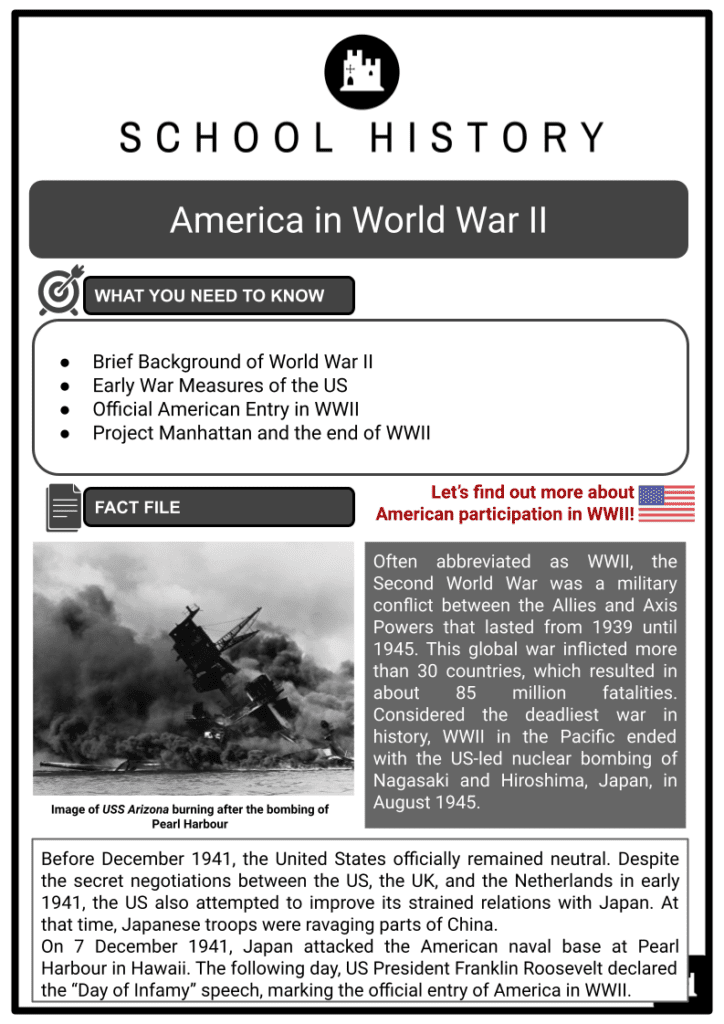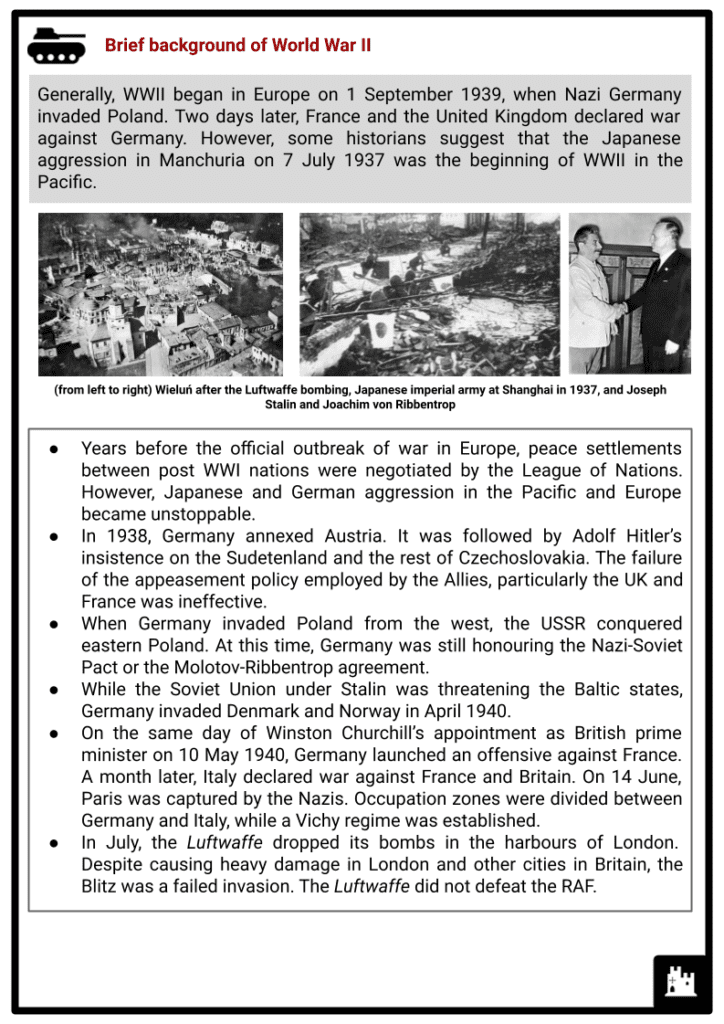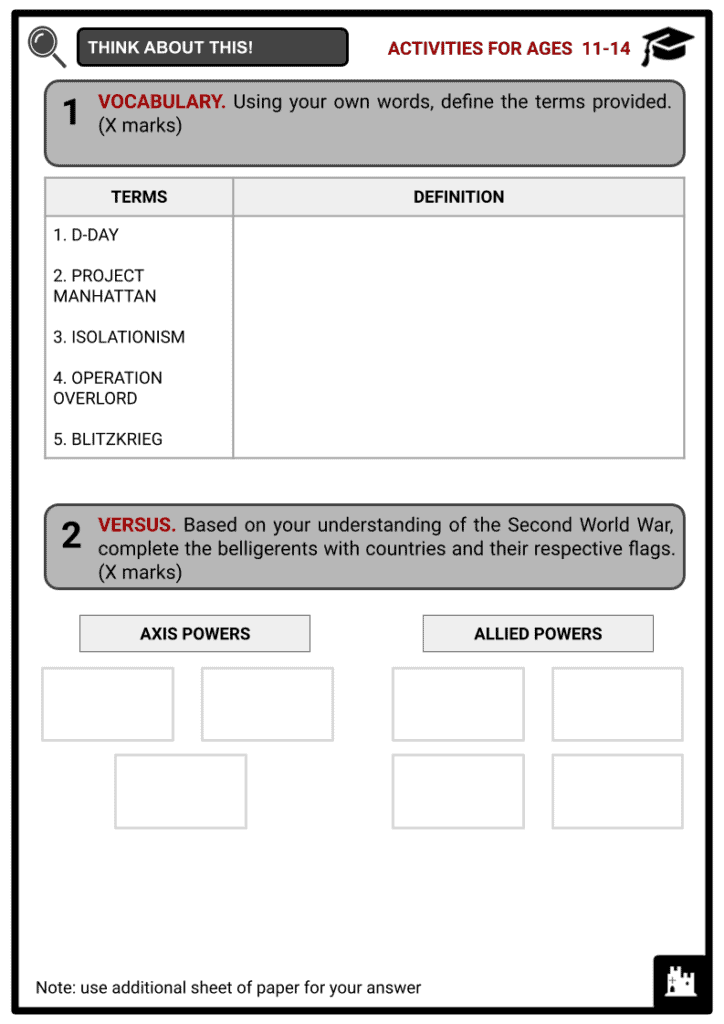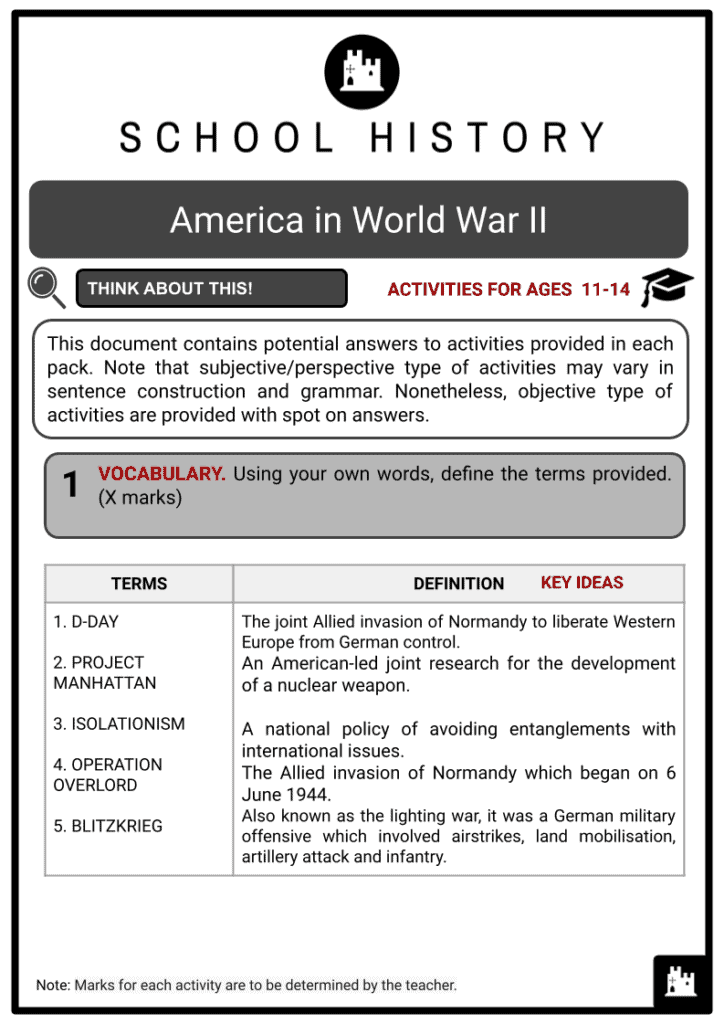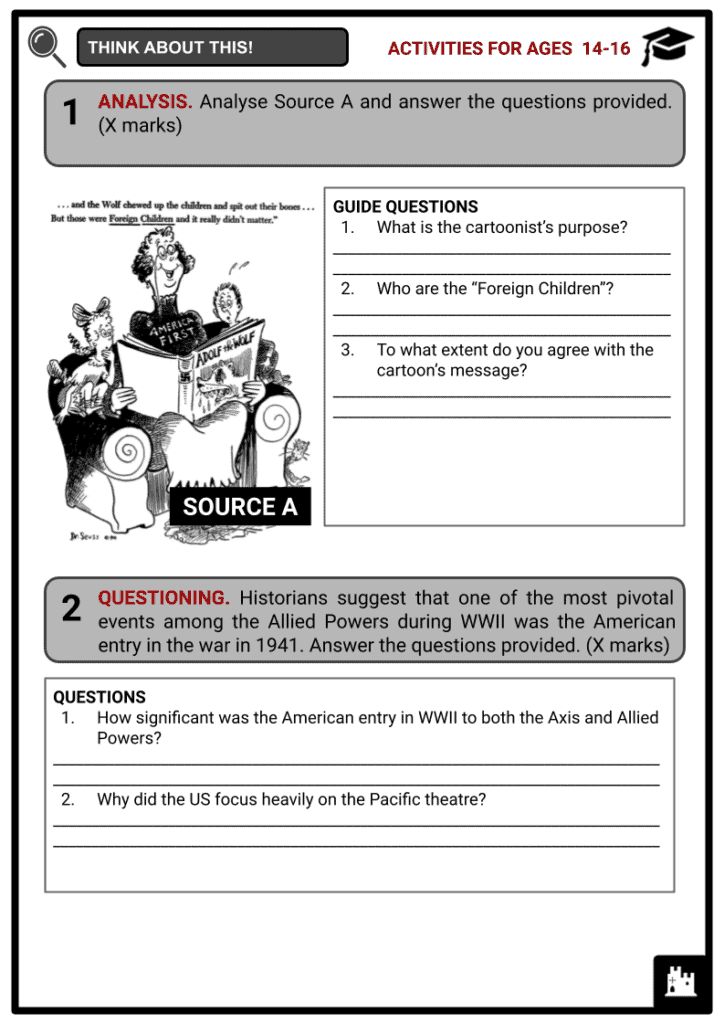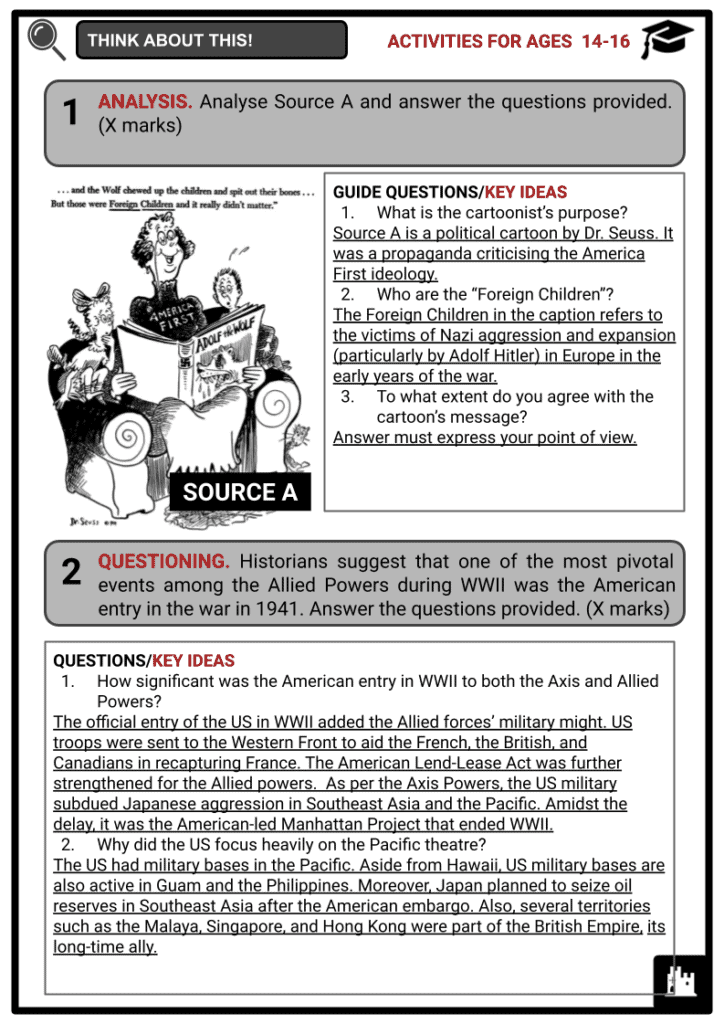Download America in World War II
Do you want to save dozens of hours in time? Get your evenings and weekends back? Be able to teach about America in World War II to your students?
Our worksheet bundle includes a fact file and printable worksheets and student activities. Perfect for both the classroom and homeschooling!
Table of Contents
Add a header to begin generating the table of contents
Summary
- Early life of Gamal Abdel Nasser
- The beginning of Nasser’s political activity
- Nasser’s power struggle with Naguib
- The political ideology of Nasser
- Nasser’s foreign policy
- The defeat in 1967
Key Facts And Information
Let’s know more about America in World War II!
- Often abbreviated as WWII, the Second World War was a military conflict between the Allies and Axis Powers that lasted from 1939 until 1945. This global war inflicted more than 30 countries, which resulted in about 85 million fatalities. Considered the deadliest war in history, WWII in the Pacific ended with the US-led nuclear bombing of Nagasaki and Hiroshima, Japan, in August 1945.
- Before December 1941, the United States officially remained neutral. Despite the secret negotiations between the US, the UK, and the Netherlands in early 1941, the US also attempted to improve its strained relations with Japan. At that time, Japanese troops were ravaging parts of China.
- On 7 December 1941, Japan attacked the American naval base at Pearl Harbour in Hawaii. The following day, US President Franklin Roosevelt declared the “Day of Infamy” speech, marking the official entry of America in WWII.
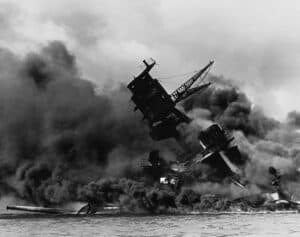
Brief background of World War II
- Generally, WWII began in Europe on 1 September 1939, when Nazi Germany invaded Poland. Two days later, France and the United Kingdom declared war against Germany. However, some historians suggest that the Japanese aggression in Manchuria on 7 July 1937 was the beginning of WWII in the Pacific.
- Years before the official outbreak of war in Europe, peace settlements between post WWI nations were negotiated by the League of Nations. However, Japanese and German aggression in the Pacific and Europe became unstoppable.
- In 1938, Germany annexed Austria. It was followed by Adolf Hitler’s insistence on the Sudetenland and the rest of Czechoslovakia. The failure of the appeasement policy employed by the Allies, particularly the UK and France was ineffective.
- When Germany invaded Poland from the west, the USSR conquered eastern Poland. At this time, Germany was still honouring the Nazi-Soviet Pact or the Molotov-Ribbentrop agreement.
- While the Soviet Union under Stalin was threatening the Baltic states, Germany invaded Denmark and Norway in April 1940.
- On the same day of Winston Churchill’s appointment as British prime minister on 10 May 1940, Germany launched an offensive against France. A month later, Italy declared war against France and Britain. On 14 June, Paris was captured by the Nazis. Occupation zones were divided between Germany and Italy, while a Vichy regime was established.
- In July, the Luftwaffe dropped its bombs in the harbours of London. Despite causing heavy damage in London and other cities in Britain, the Blitz was a failed invasion. The Luftwaffe did not defeat the RAF.
- Before the American entry in WWII, President Roosevelt remained neutral. However, several war measures were taken. In the 1930s, the US Congress passed a series of acts known as the Neutrality Acts in response to the growing tensions in the Pacific and Europe.
- Following the American involvement in the First World War, the US was hesitant to be directly involved in another global conflict. As a result, isolationism and non-interventionism grew.
- In response to the Italian invasion of Ethiopia, President Roosevelt invoked the passage of the Neutrality Act of 1935 which banned arms and ammunition shipments to both countries. The following year, the provisions of the act was renewed to forbade loans or aids to belligerents.
- In 1937, a joint resolution of the US Congress prohibited arms trade and transport of passengers to and from Spain (which was then under a civil war). In the same year, the Second Sino-Japanese War broke out. President Roosevelt did not invoke the Neutrality Act but indirectly supported China with the use of British ships.
- Following the German invasion of Czechoslovakia and Poland, President Roosevelt lobbied Congress about America’s passiveness. On 4 November 1939, Roosevelt signed the Neutrality Act into law, which ended the arms embargo by allowing arms trade to Britain and France on a cash-and-carry scheme.
- In March 1941, months prior to the bombing of Pearl Harbour, the Lend-Lease Act was passed which ended America’s neutrality policy. Under the Lend-Lease Act, American war materials were sold and given to Britain, China, and France.
- On 11 September 1941, in response to repeated German submarines attacks against US ships, Roosevelt advised the US Navy to defend their waters.
- On 17 November, provisions of the Neutrality Acts were repealed after the sinking of US destroyer Reuben James in October.
- Meanwhile in Eastern Europe, despite the earlier Nazi-Soviet Pact, Hitler launched Operation Barbarossa on 22 June 1941. Hitler believed that the Soviet Union was plotting against Germany and that a tripartite alliance with Britain and the US was waiting.
Official American Entry in WWII
- Along with the US, Britain, Canada, the Netherlands, and Australia declared war on Japan. Before the bombing of the Pearl Harbour, Japan engaged in simultaneous attacks on Hong Kong, Vietnam, Cambodia, Myanmar, the Philippines, Singapore, Malaya, and Thailand. Historians suggest that the Japanese aggression in Southeast Asia and the Pacific was motivated by becoming a global power. Moreover, Japanese expansion in Indochina and Dutch East Indies was to acquire oil reserves since the US ceased oil imports in July 1941.
- At this time, the US, Britain, and the Netherlands had territories in Southeast Asia. On 20 November 1941, Japan, led by Hideki Tojo and Emperor Hirohito, proposed to withdraw their troops from southern Indochina and leave Southeast Asia if the US, Britain, and the Netherlands lifted its sanctions and ceased from aiding China. Six days later, the US sent the counter proposal which required the Japanese to free China without any conditions.
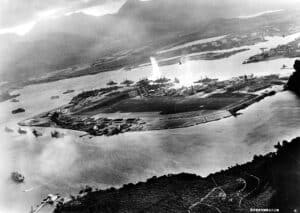
- At 7:48 o’clock in the morning, the naval base at Pearl Harbour in Honolulu, Hawaii was attacked by the Imperial Japanese Navy Air Service.
- The Hawaii Operation was an offensive attack by Japan to prevent the US from engaging in Southeast Asia.
- Pearl Harbour was attacked by 353 Japanese fighters, bombers, and torpedo planes launched from six aircraft carriers. Four out of eight US Navy battleships sunk, while the remaining were heavily damaged.
- Furthermore, the Japanese attack destroyed 188 US aircraft, 3 cruisers, 3 destroyers, and killed 2,402 and wounded 1,282 Americans.
- Meanwhile, Japanese lost 29 aircrafts and 5 midget submarines.
- Tokyo declared war against the US and the British Empire later that day (8 December), but wasn’t delivered until the next day. Despite having no formal obligation under the Tripartite Pact, Germany and Italy declared war against the US on 11 December 1941. In response, the US did the same.
- From isolationism and neutrality, the American public supported the war.
- On 1 January 1942, the Big Four (US, UK, China, and the USSR) led the Declaration by United Nations which affirmed the Atlantic Charter previously drafted by Churchill and Roosevelt. The declaration was also participated by other 22 countries.
- Before the end of May 1942, Japan and its conquered Thailand, successfully invaded the Dutch East Indies, Singapore, Burma, Malaya, New Guinea (Rabau), and the Philippines.
- On 15 February 1942, the surrender of Singapore marked the largest British-led military defeat. Meanwhile, in Corregidor, Philippines, the combined Filipino-American forces was also defeated by the Japanese. About 70,000 Filipino-American forces became prisoners. Filipino historians suggest that the long resistance to invasion in the Philippines delayed the Japanese attack on Australia.
- The Japanese was also successful in seizing oil reserves from Borneo, Central Java, Cepu, Sumatra, Malang, and Dutch New Guinea.
- Due to the ongoing war on the Eastern Front, North America and the Middle East, Allied forces (Dutch, British and Australian) were short on personnel, thus provided limited aid in the Pacific. On 10 December 1941, British warships HMS Repulse and HMS Prince of Wales were sunk by the Japanese in the Malaya. On 1 January 1942, the ABDACOM (American-British-Dutch-Australian Command) appointed British General Sir Archibald Wavell as the overall commander of the Allied forces.
- Fought in the Pacific theatre, the Battle of Midway was a naval encounter between the Japanese and American naval forces on 3-6 June 1942. Led by Admiral Isoroku Yamamoto, the Japanese Imperial Navy believed that they could finally defeat the US and replicate their victory at Pearl Harbor. A surprise attack was planned by Yamamoto on the US Pacific Fleet based at Midway Island.
- In early 1942, US Navy cryptanalysts had decoded Japanese communication lines on planning to attack the Pacific at a location they called ‘AF’. Given the information, Admiral Chester Nimitz, commander-in-chief of the US Pacific Fleet, developed a plan. On 3 June, the US B-17 Flying Fortress bombers mistakenly assumed the Japanese fleet led by Vice Admiral Nobutake Kondo as the main invasion fleet.
- Following the second unsuccessful US attack on Kondo’s force, Vice Admiral Chuichi Nagumo sent four aircraft carriers with 108 warplanes to bombard the US base at Midway Islands.
- Meanwhile, US torpedo bombers from carriers Hornet and Enterprise were shot down by Japanese Zero fighters. While refuelling and rearming, Japanese carriers - Akagi, Kaga and Soryu were bombed by US dive bombers. The last surviving Japanese carrier Hiryu was also set ablaze. On 6 June, a Japanese submarine launched torpedoes and sank USS Hammann and Yorktown.
- On the same day, Yamamoto ordered his navy to retreat. By the end of the Battle of Midway, the Japanese lost about 3,000 men, 4 aircraft carriers, 1 heavy cruiser and about 300 aircraft, while the Americans lost Yorktown and Hammann, 360 servicemen and about 145 aircrafts.
- This huge loss of the Japanese Imperial Navy halted Japan’s ambition of conquering the Pacific. According to historian Walter Lord, it was an “incredible victory” for the US Navy.
- On 18 April 1942, the United States launched the first air raid on Tokyo known as the Doolittle Raid. This served as retaliation for the attack on Pearl Harbor in December. Led by Lieutenant Colonel James Doolittle, 16 B-25B Mitchell bombers were tasked to bomb targets in the Japanese archipelago. 15 of 16 aircraft bombers crashed in China, while the last one landed at Vladivostok, USSR.
- In September 1942, the Australian land forces defeated the Japanese marines at the Battle of Milne Bay in New Guinea which marked Japan’s land defeat in the Pacific. On 20 October 1944, General MacArthur and the US Sixth Army landed on Leyte (a province in the islands of Visayas). From the south, a series of battles were fought by the US army and local guerilla units until the liberation of the Philippines in 1945. In the summer of 1944, airfields in Saipan and Guam were also recaptured by the Americans.
- On 9-10 May, 1945, Operation Meetinghouse was launched by the USAAF (United States Army Air Forces) on Tokyo. This heavy firebombing of the Japanese capital city killed more than 90,000 people. Prior to this, air raids in Japanese industrial cities and ports had already begun.
- In addition to Tokyo, several bombing raids were also conducted in major Japanese cities of Nagoya, Osaka, Kobe, Toyama and Yokohama. On 5 April 1945, the USSR did not renew its nonaggression treaty with Japan. By 21 June, American ground forces invaded Okinawa which was then regarded as the bloodiest campaign in the Pacific since the Guadalcanal in 1942.
- Also known as the Battle of Normandy, the D-Day landings were an Allied invasion to liberate Western Europe from German control. Under codename Operation Overlord, the invasion of Normandy began on 6 June 1944.
- Since 1943, a massive deception operation was planned by the Allies. In January 1944, US General Dwight Eisenhower was appointed as commander of Operation Overlord. The Germans believed that the Allied invasion target was Pas-de-Calais (located at the narrowest point in the English Channel). In addition to a fake build-up of troops parallel to Pas-de-Calais, the Allies used dummy equipment, double agents and fraudulent radio transmissions.
- After a day of delay due to bad weather, the D-Day landings began on 6 June 1944.
- In addition to the Pacific front, between March 1944 and April 1945, the American Eighth Air Force conducted their own bomber offensive in Berlin. Led by Major General Jimmy Doolittle, the USAAF attacked Berlin and forced a direct assault with the Luftwaffe.
- By 6:30am, British, American and Canadian troops landed on five beach points - Utah and Omaha beaches (US), Juno (Canada), Gold and Sword (Britain). Amongst the beach landings, Omaha suffered great casualties. About 2,000 American troops were slaughtered upon stepping ashore in Normandy.
- Following Eisenhower’s approval to liberate Paris, the 2nd Armored Division and the 4th Infantry Division advanced to Paris. On the night of 24 August, about 20,000 of the German troops surrendered or fled. By the next morning, the western and eastern half of Paris was liberated. Choltitz was arrested on the same day. He signed a document which officially surrendered Paris to de Gaulle’s provisional government.
Manhattan Project and the end of WWII
- As early as 1939, American physicists learned of intelligence reports about the German development of nuclear fission. By June 1941, the Office of Scientific Research and Development was created by the US. This new agency conducted joint research with the war department for the development of a nuclear weapon under the Manhattan Project.
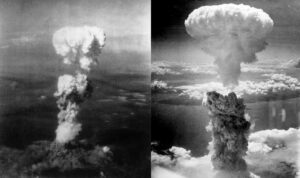
- On 16 July 1945, after four years of intensive research, an atomic device was tested in a desert near Alamogordo, New Mexico. At that time, despite several firebombing operations, Japan refused to surrender. US President Harry S. Truman then believed that the new atomic bomb, a monstrous weapon, would more likely defeat Japan than any conventional invasion.
- On 6 August 1945, an atomic bomb was dropped on the city of Hiroshima, Japan. Three days later, on 9 August, another one was dropped on Nagasaki. 60% of Hiroshima’s infrastructure was destroyed. Around 140,000 people were killed in Hiroshima and 74,000 people in Nagasaki. Over the next five years, people died en-masse from the effects of radiation.
- While the destruction of atomic bombs was heard in Tokyo, the USSR declared war on Japan on 8 August. Two days later, the Japanese government agreed to surrender under the terms stipulated in the Potsdam Declaration.
- The Japanese government particularly requested the unaltered sovereign status of Emperor Hirohito. On 14 August, Japan agreed on the terms and Emperor Hirohito addressed the Japanese public to surrender. On 2 September, new Prime Minister Suzuki Kantarō survived an attempted assassination by war diehards.
- Also on 2 September 1945, a formal ceremony of surrender took place at USS Missouri in Tokyo Bay. The Allies were generally represented by military leaders MacArthur and Nimitz, while the Japanese sent Shigemitsu Mamoru and Umezu Yoshijiro.
- From isolationism, the US increased its international involvement after WWII. Aside from political influence, the US became a global economic and technological superpower.

